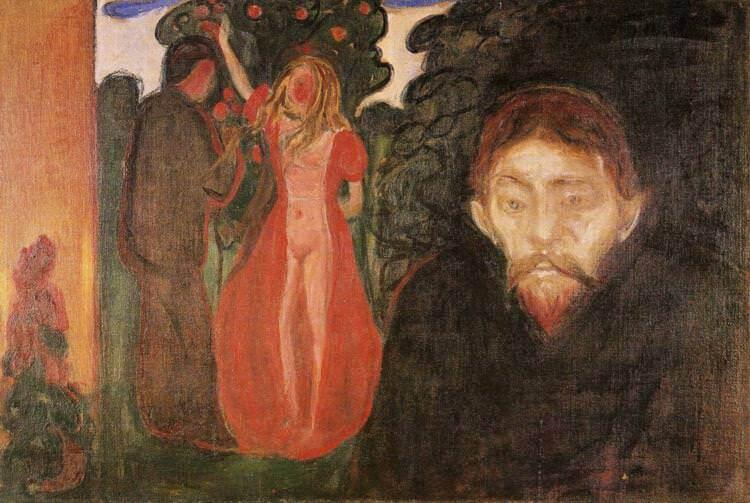Introduction
Love, passion, and romance have always been an inherent part of human history, influencing individual lives and the stories of entire populations. The exploration of various sides of romantic relationships, therefore, lies at the core of the humanities’ research – it helps one understand how people acted towards each other and themselves. Apart from positive feelings, love is also a cause of people’s struggles, and jealousy is one of the problems that is often born out of affection. The topic of jealousy in art and literature allows one also to explore such themes and loss, anger, possessiveness, and many more. It can provide great insight into the lives of humans throughout history, thus being a vital subject for investigation in the Humanities.
Examples
This paper looks at three works that focus on jealousy – Othello by Shakespeare, Jealousy by Munch, and “An Attempt at Jealousy” by Tsvetaeva. The first one, Othello, is a tragedy that was written by William Shakespeare in 1603. Shakespeare was an English playwright whose works are regarded as the greatest writing in the English language. As the play considers the themes of love, racism, and betrayal, it is also considered by critics as a commentary on interracial marriage, which was had much opposition during the time of the play’s creation. This and other information about the tragedy can be found in the book Othello published by Cambridge University Press.
The second work is Jealousy, a painting by Edvard Munch created in 1895. Munch was a Norwegian artist who worked in the style of Expressionism. The context of the art is the artist’s own suspicions of his wife’s romantic relationships with Stanisław Przybyszewski – a poet and a friend of Munch. The work now belongs to the Rasmus Meyer Collection, but it can be found online (see fig. 1).

The final piece of art is a poem by Marina Tsvetaeva, “An Attempt at Jealousy,” written in 1924. Tsvetaeva was a Russian poet who left Russia for Europe near the end of the Russian Revolution. This poem was written during her travels, and it is possible that her immigrant life influenced it. The theme of jealousy is clear from the very first line – “How is your life with that other one?” (Tsvetaeva). The translations of this and other poems can be found online, including the website Poetry Foundation.
Interpretation
First, Shakespeare’s play can be interpreted by its motifs, central ideas, which revolve around sexual desire and jealousy that appears from the inside of the character’s mind. In the tragedy, Shakespeare describes this feeling as a “green-eyed monster which doth mock / The meat it feeds on,” implying the destructive nature of jealousy and the danger that it brings to the person having it (182). Moreover, the idea that jealousy blinds the person to logical explanations and grows on itself is further indicated, “But jealous for they are jealous: ’tis a monster / Begot upon itself, born on itself” (Shakespeare 220). Thus, the clear signs of the characters’ demise are given by the author to his audience – Shakespeare combines the motifs of monstrosity, blind rage, and destruction to portray Othello’s feelings.
Munch’s painting, Jealousy, shows how the feeling is portrayed in composition, the placement of elements on a canvas. Notably, the romantic scene between the painter’s wife and Munch himself (potentially) is in the background, while the face of Przybyszewski, is in the foreground. Such use of space separates the couple from the third person, creating tension between the two elements. Therefore, a conflict is not between the painter and his friend but between a marriage and a person who endangers it.
Finally, one can analyze the poem by Tsvetaeva with the help of the tone or mood she chooses. In this case, the character’s relationship is over, and she appears bitter, taunting her ex-lover’s new relationship. She compares herself to the other woman, painting the latter as inferior – she is “plaster-dust,” an “earthly woman” with no “sixth sense” (Tsvetaeva). In this case, jealousy makes Tsvetaeva want for her ex-partner to feel miserable, just as she does in her new relationship.
Impact
All considered examples represent jealousy in their own way, but their authors succeed at showing how divisive and destructive this feeling can be. Othello’s ending is the most transparent in this regard – Othello, blinded by jealousy, kills his wife. Then, he kills himself when he finally uncovers the truth of her faithfulness. Thus, the playwright represents the nature of jealousy as a beast that grows on its own perfectly. Munch’s portrayal is more subtle, but, through composition, he also depicts how jealousy leads to ties being broken – the rift between the man in the couple is heightened by the colors that separate them. Finally, Tsvetaeva’s poem presents a type of jealousy that happens when the relationship has ended, but one of the partners cannot wish for the other to be happy. The author asks, “how is your life, / my beloved” because she wants it to be “Hard as mine / with another man” (Tsvetaeva). Jealousy that plagues’ one mind after the relationship continues to destroy joy.
Conclusion
To sum up, authors can show different sides of jealousy, but all manifestations of this feeling corrupt relationships and people’s trust and compassion for each other. This representation leads one to believe that jealousy was a part of people’s romantic relationships forever. Shakespeare reveals the dangers that jealousy built on suggestions and fears may bring. Munch depicts how this emotion haunts people’s thoughts and separates them. Tsvetaeva’s interpretation describes a lingering dissatisfaction that jealousy only empowers.
Works Cited
Munch, Edvard. Jealousy. 1895. Rasmus Meyer Collection, Bergen. Edvard Munch.Org.
Shakespeare, William. Othello. Edited by Julie Hankey. 2nd ed., Cambridge University Press, 2005.
Tsvetaeva. “From ‘An Attempt at Jealousy’ by Marina Tsvetaeva.” Poetry Foundation, 1924.